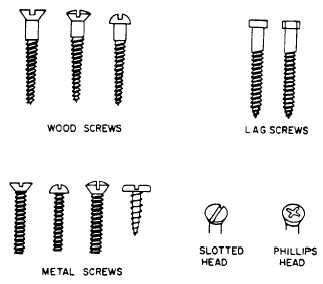roundhead, as illustrated in that order in figure 3-79, All of these screws can have slotted or Phillips heads.
To prepare wood for receiving the screws, bore a body hole the diameter of the screw to be used in the piece of wood that is to be fastened (figure 3-80). You should then bore a starter hole in the base wood with a diameter less than that of the screw threads and a depth of one-half or two-thirds the length of the threads to be anchored. The purpose of this careful preparation is to assure accuracy in the placement of the screws, to reduce the possibility of splitting the wood, and to reduce the time and effort required to drive the screw. Properly set slotted and Phillips flathead and oval head screws are countersunk sufficiently to permit a covering material to be used to cover the head. Slotted roundhead and Phillips roundhead screws are not countersunk, but they are driven so that the head is firmly flush with the surface of the wood. The slot of the roundhead screw is left parallel with the grain of the wood.
The proper name for a lag screw (shown in figure 3-79) is lag bolt or wood screw. These screws are often required in constructing large projects, such as a building. They are longer and much heavier than the common wood screw and have coarser threads that extend from a cone, or gimlet point, slightly more than half the length of the screw. Square-head and hexagonal-head lag screws are always externally driven, usually by means of a wrench. They are used when ordinary wood screws would be too short or too light and spikes would not be strong enough. Sizes of

Figure 3-80.-Proper way to sink a screw.
lag screws are shown in table 3-11. Combined with expansion anchors, they are used to frame timbers to existing masonry.
Expansion shields, or expansion anchors as they are sometimes called, are used for inserting a predrilled hole, usually in masonry, to provide a gripping base or anchor for a screw, bolt, or nail intended to fasten an item to the surface in which the hole was bored. The shield can be obtained separately, or it may include the screw, bolt, or nail. After the expansion shield is inserted in the predrilled hole, the fastener is driven into the hole in the shield, expanding the shield and wedging it firmly against the surface of the hole.
For the assembly of metal parts, sheet metal screws are used. These screws are made regularly in steel and brass with four types of heads: flat, round, oval, and fillister, as shown in that order in figure 3-79.
Wood screws come in sizes that vary from 1/4 inch to 6 inches. Screws up to 1-inch in length increase by

Figure 3-79.-Types of screws.
Continue Reading